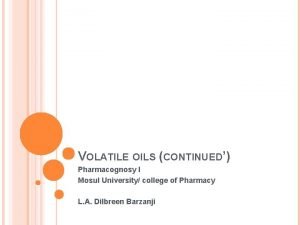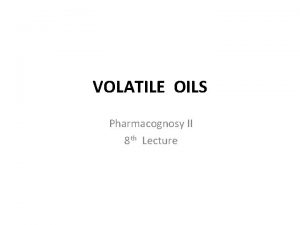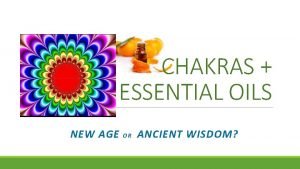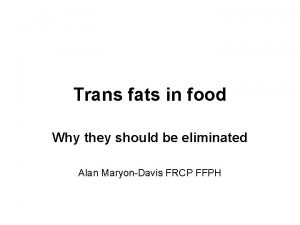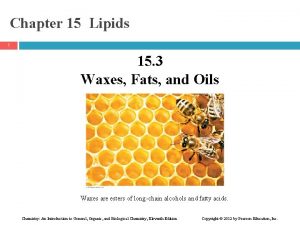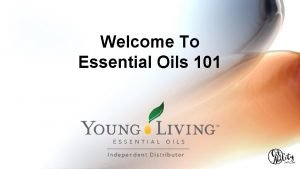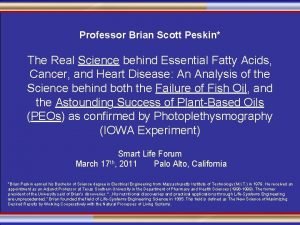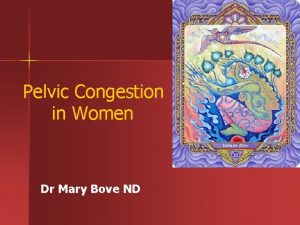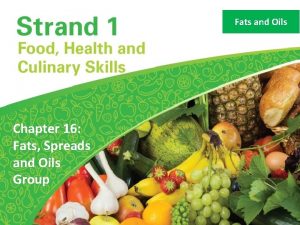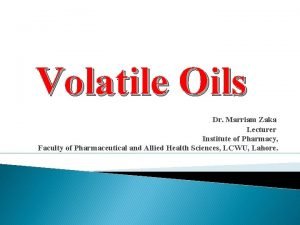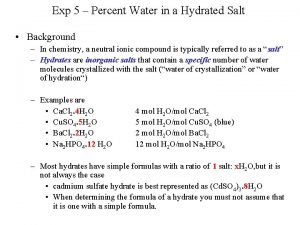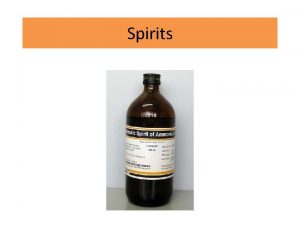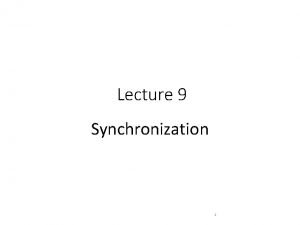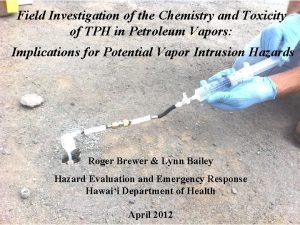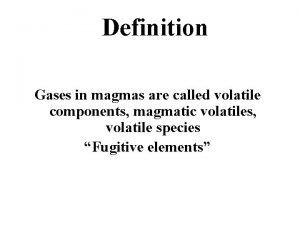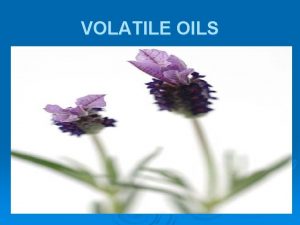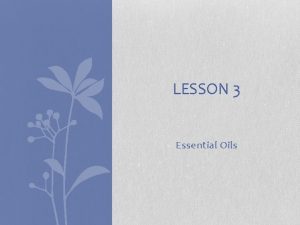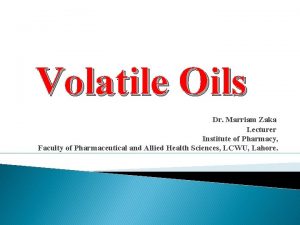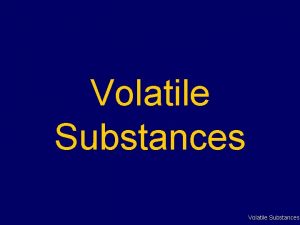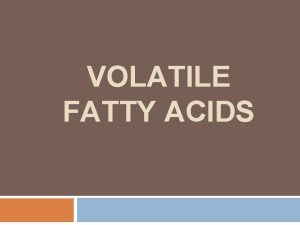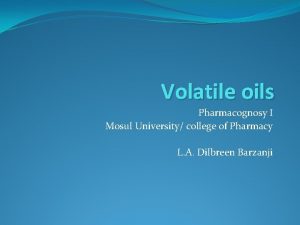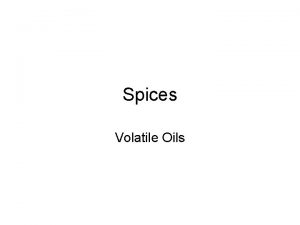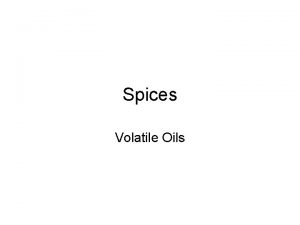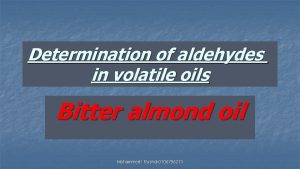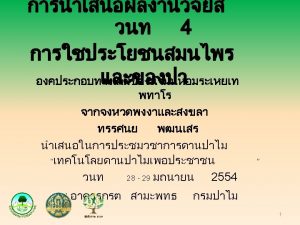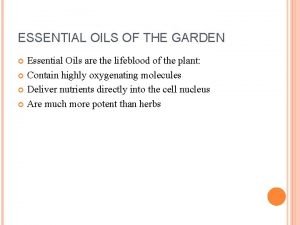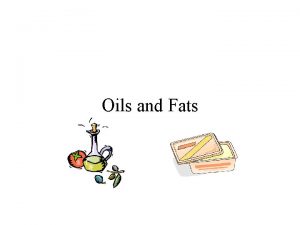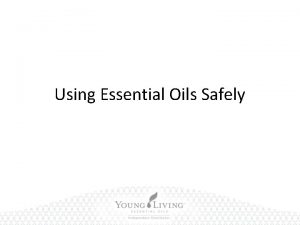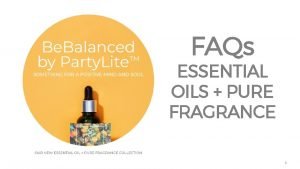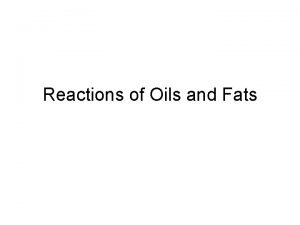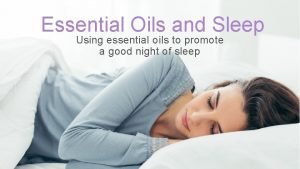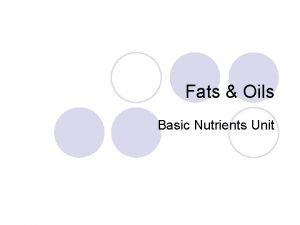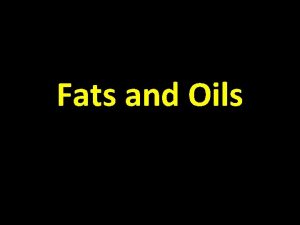VOLATILE OILS Arifur Rahman Lecturer Department of Pharmacy





































































- Slides: 69

VOLATILE OILS Arifur Rahman Lecturer Department of Pharmacy BRAC University

VOLATILE OILS • Volatile oils are mono- and sesquiterpenes obtained from (the odorous principle) various plant parts. • They may be formed directly by protoplasm or by decomposition of the resinogenous layer of the cell wall or by hydrolysis of certain glycosides. • Most of the volatile oils are evaporate when they are exposed to the air at ordinary temperature (36 -38°). • Volatile oils are sometimes called essential oils because they represent the ‘essence’ or the active constituents of the plants.

• Volatile oils are also called ethereal oil due to its ether like behavior, which is they are volatile and evaporates even in room temperature. Example: peppermint oil, Clove oil. FIXED OILS: • Fixed oils are esters of long chain fatty acids and glycerols or closely related derivatives. Fixed oils are obtained from either plants or animals. Most fixed oils are liquid at room temp but there are some exceptions. Cocoa butter is solid vegetable oil. Example: Caster oil, Peanut oil, Olive oil, Coconut oil.

DIFFERENCE BETWEEN FIXED 0 IL AND VOLATILE OIL Volatile oil Fixed oil Volatile oil can easily vaporize at normal temp. Fixed oil can’t easily vaporize at normal temp. Have characteristics odor. Fixed oils are odorless. It can be distilled/ extracted It can’t be distilled/ from their natural source. extracted from their natural source. On exposure to light and On exposure, become air, they oxidize and resinify rancid

They don’t contain the glycerol esters and fatty acids. They cannot be saponified They can be saponified with alkali. They don’t leave They leave permanent grease spot on Paper Low boiling point. High boiling point. Low molecular weight. High molecular weight. Most of them are optically Optically inactive

PROPERTIES OF VOLATILE OILS: Physical properties: • They possesses characteristics odor. • They evaporate when they exposed to the air at ordinary temperature. • Most of them are optically active. • They are slightly soluable in water and readily soluable in ether, alcohol and most organic solvent. • Usually colourless. • Reasonably heat stable

Chemical properties: • They may be hydrocarbons, alcohol, aldehyde, ketone, phenolic ether, oxides and esters. • They can’t be saponified with alkalies. • The volatile oils largely consists terpenes and phenyl propanoids.

METHODS OF OBTAINING VOLATILE OILS There are some methods for obtaining volatile oils from crude drugs. These are 1. Distillation: Volatile oils are usually obtained by this method. Distillation is further divided into three methods: i. Water distillation ii. Water and steam distillation iii. Direct steam distillation

i. Water distillation • It is applied to plant material that is dried and not subject to injury by boiling. • Turpentine oil is obtained by this method. • The crude turpentine oleoresin is introduced into the distilling chamber and subjected to heat until all the volatile matter both oil and water is condensed in the condensing chamber. • Turpentine oil, consisting almost entirely of terpenes, is not affected by this amount of heat.

ii. Water and Steam distillation • It is employed for substances either dried or fresh that may be injured by boiling. • In the case of dried material (cinnamon or clove), the drug is ground and then covered with a layer of water, and steam is passed through the macerated mixture. • Since the oil might be impaired by direct boiling, the steam is generated elsewhere and is piped into the container holding that drug. • The oily layer of the condensed distillate is separated from the aqueous layer, and the oil may be marketed with or without further processing.

iii. Steam distillation • This method is applicable to fresh plant drugs (peppermint, spearmint). • The crop is cut and taken directly to the distilling chamber. • Instead of being allowed to macerate, the drug is suspended on a grid. Since the plant material is still green and contains natural moisture, no maceration is necessary.

• Steam is forced through the fresh herb carrying the oil droplets to the condensing chamber. • During steam distillation hydrolysis (volatile component) and decomposition (other constituents) is a major problem. Hydrolysis and decomposition should be kept as minimum as possible

2. Hydrolysis: Glycosidic volatile oils are obtained by the enzymatic hydrolysis of the glycosides. E. g. Mustard oil. 3. Expression: e. g. lemon oil. 4. Ecuelle method: e. g. lemon oil. 5. Enfleurage: e. g. Rose oil. 6. Extraction: Using solvents such as petroleum ether or benzene. E. g. Sandalwood. 7. Destructive distillation: e. g. Eucalyptus oil.

Difference between three types of distillation method Water distillation Water and steam distillation Direct steam distillation Only dried material can be used. Both dried and fresh material can be used. Only fresh material can be used. Maceration is not needed. Maceration needed. The crude drug is placed in the boiling chamber. The macerated drugs is placed in a separate container. Crude drug is hanged from the top of the container. Temperature should be above 100°c Temperature should be 6070°c. i. e. low. Temperature should be medium (80 -85°c) e. g. Turpentine oil e. g. Clove oil, Cinnamon oil. e. g. peppermint oil, spearmint oil. is not

IMPORTANCE OR USES OF VOLATILE OILS Therapeutic /medicinal importance i. Carminative (Clove Oil) ii. Antiseptic (Eucalyptus Oil) iii. Antispasmodic (Peppermint Oil) iv. Stimulant (Clove Oil) v. Astringent (Nutmeg Oil) vi. Antibacterial (Pine Oil) vii. Anti Infective (Camphor Oil) viii. Anti Fungual (Thymol oil) ix. Expectorant (Eucalyptus Oil) x. Antirheumatic (Wintergreen Oil)

Pharmaceutical importance: i. Pharmaceutical aid (flavour) ii. Perfume and Cosmetic Preparation iii. Masking bad odor in Pharmaceutical Preparation iv. Sometimes it is used main constituents of drug preparation v. Preservatives Importance for plants: • Volatile Oils acts as repellent of insects • Thus preventing from destruction of the flowers and leaves • Act as an insect attractant. Thus aiding in cross fertilization of the flowers

DEFINITION OF VOLATILE OILS Volatile oils are products which are generally complex in composition, consisting of the volatile principles contained in plants, and are more or less modified during the preparation process. Only 2 procedures may be used to prepare official oils i. Steam distillation ii. Expression 4 Main types of volatile oils i. Concretes ii. Pomades iii. Resinoids iv. Absolutes

CONCRETES Prepared from raw materials of vegetable origin (bark, flowers, leafs, roots etc. ) Extracted by HC type solvents, rather than distillation or expression – Becomes necessary when the essential oil is adversely affected by hot water or steam (e. g. jasmine). Produces a more true-tonature fragrance.

CONCRETES Concretes contain about 50 % wax and 50 % essential oil (jasmine). Ylang ylang (concrete volatile) contains 80 % essential oil and 20 % wax. Advantages of concretes: they are more stable and concentrated than pure essential oils.

POMADES True pomades are (volatile oil) products of a process known as enfleurage (hot or cold). Enfleurage is used for obtaining aromatic materials from flowers containing volatile oils to produce perfume long after they were cut.

ENFLEURAGE: METHOD A glass plate is covered with a thin coating of especially prepared and odourless fat (called a chassis). The freshly cut flowers are individually laid on to the fat which in time becomes saturated with their essential oils. The flowers are renewed with fresh material. Eventually the fragrance-saturated fat, known as pomade, may be treated with alcohol to extract the oil from the fat.

RESINOIDS Prepared from natural resinous material (dried material) by extraction with a non-aqueous solvent, e. g. Petroleum ether or hexane. E. g. Balsams – Peru balsam or benzoin; resins (amber or mastic); Oleoresin (copaiba balsam and turpentine); Oleogum resins (frankincense and myrrh)

RESINOIDS Can be viscous liquids, semi-solid or solid. Usually homogeneous mass of non-crystalline character. Uses: in perfumery as fixatives to prolong the effect of a fragrance.

ABSOLUTES Obtained from a concrete, pomade, or a resinoid by alcoholic extraction. The extraction process may be repeated. The ethanol solution is cooled & filtered to eliminate waxes. The ethanol is then removed by distillation. They are usually highly concentrated viscous liquids.

TERPENES • Terpenes, are natural products whose structures may be divided into isoprene units. isoprene

CLASSIFICATION OF TERPENES • Terpenes are classified by the number of 5 -C atoms they contain. • Hemiterpenes consist of a single isoprene unit. Isoprene itself is considered the only hemiterpene. • 10 -Carbon terpenes (contain 2 C-5 units) – monoterpenes • 15 - Carbon terpenes sesquiterpenes. (3 C-5 units) are called • 20 -carbon terpenes (4 C-5 units) are diterpenes. • Larger terpenes (30 carbons) are called triterpenes (triterpenoids), • 40 Carbons - called tetraterpenes and polyterpenoids.

TERPENOIDS • When terpenes are modified chemically, such as by oxidation or rearrangement of the carbon skeleton, the resulting compounds are generally referred to as terpenoids. • Terpenoids contain only the most volatile terpenes (i. e. molecular weight is not too high) mono and sesquiterpenes

MAJOR CLASSES OF VOLATILE OILS • Hydrocarbon Volatile Oils • Alcohol Volatile Oils • Aldehyde Volatile Oils • Ketone Volatile Oils • Phenolic Ether Volatile Oils • Oxide Volatile Oils • Ester Volatile Oils

1. HYDROCARBON VOLATILE OILS Turpentine oil • Botanical source: Pinus palustris • Family: Pinaceae • Constituents: 65 % α pinene 30 % β pinene 3% other terpines • Rectified turpentine oil : It is the turpentile oil rectified by distillation from aqueous solution of sodium hydroxide.


Α PINENE AND Β PINENE α pinene β pinene

Use: 1. Local irritant 2. Mild antiseptic 3. rubefacient Industrial use: 1. Insecticides 2. Solvent 3. In the production of synthetic camphor 4. Furniture polish Pharmacological use: 1. Carminative 2. Tonic 3. Diuretic 4. Expectorant

2. ALCOHOL VOLATILE OILS Peppermint oil : Botanical source: It is obtained from dried leaf and flowering top of Mentha piperita Family: Labiatae

Geographical source: It is indigenous to Europe, Northern United States and Canada. Constituents: 1) 50 -78 % of free menthol 2) 5 -20 % acetate 3) Mentone 4) Cineole


PEPPERMINT OIL Use: 1. flavour 2. carminative 3. stimulant 4. mild antiseptic Commercial use: 1. Flavour for chewing gum 2. Flavouring agent in candy, toothpaste, jellies

Cardamon oil/ Cardamom oil Botanical source: Elettaria cardamom Family: Zingibereraceae Geographical source : India, Srilanka, Guatemala

Constituent: 26 -40 % cineole 28 -34 %Terpinyl acetate 2 -14 % limonene 3 -5 % sabinene 2 -8 % linalyl acetate Use: Flavour Carminative stimulant

CINEOLE, LIMONENE AND SABINENE Cineole Limonene Sabinene

Coriander oil : Botanical source: Coriandrum sativum Family: Umbelliferae Geographical source : India, Morocco, Eastern Europe, Mexico, United States, Argentina

Constituent: 60 -70% linalool Limonene α pinene Geraniol Cymene Camphor Use: Flavour Carminative spice in cooking

Limonen e α pinene

Linalool Cymene

Geraniol Camphor

3. ALDEHYDE VOLATILE OILS Cinnamon oil: It is the dried bark of Cinnamomum loureirii Family: Lauraceae Geographical source: Srilanka, China, Vietnam, West Indies.

Constituent: 1) 60 -70% cinnamaldehyde 2) 5 -10% eugenol 3) Benzaldehyde 4) Cuminaldehyde 5) Pinene 6) cymene Use: 1. Antiseptic 2. Carminative 3. Stimulant 4. Flavor 5. Condiments

Cinnamaldehyde Eugenol

Benzaldehy de Cuminaldehyde

4. KETONE VOLATILE OILS Camphor oil: Botanical source: Cinnamomum camphore Family: Lauraceae Geographical source: Japan, China, Srilanka, Africa, Egypt, Brazil

Constituent: 1. Safrole (Used in making perfume and soap) 2. Camphor(as a liniment and treatment for colds) 3. Eugenol 4. Cineole 5. d-pinene 6. Eucalypt 0 l

Safrole Cineole

Eugenol Eucalyptol

Use : 1. Rubefacient 2. Counter irritant 3. Flavor in toothpowder, soaps and cosmetic products. Camphor

SPEARMINT OIL: Botanical source: Mentha spicata Family: Labiatae Geographical source: North America, Washington, India, Michigan. Constituent: 45 -60 % Carvone 6 -zo% alcohols 4 -20% esters, terpenes mainly limonene, cineole

Cineole Limonene

Use: 1. Flavoring 2. Carminative 3. Chewing gum industry 4. Mouthwash Carvone

5. PHENOL VOLATILE OILS Clove oil: Botanical source: Eugenia caryophyllus Family: Myrtaceae Geographical source: Penang, Ambon, Pemba, Sumatra

Constituent: • 85 -90% eugenol • Acetyl eugenol 3 % • Tannins • Oleanolic acid • Carbinol • Vanillin • Dirnethyl furfural Vanillin

Eugenol Carbinol

USE 1. Carminative 2. Flavor 3. Counter irritant 4. Antispasmodic 5. Local analgesic and antiseptic in dentistry 6. In preparation of vanillin

6. PHENOLIC ETHER VOLATILE OILS Nutmeg : Botanical source: Dried kernels of Myristica fragrans Family: Myristicaceae Geographical source: it is native to Indonesia It is cultivated in Malay, Sumatra, Java, Srilanka, West Indies

Constituent: Safrole Myristicin Methoxyeugenol Camphene Alpha and beta pinene Palmitic, oleitic and lauric acids. Safrole α pinene

Limonene Methoxyeugenol

β pinene Myristicin

USE: • Carminative • Astringent • Nausea • Useful for controlling dirrhoea • Vomiting • Antibacterial activity • Flavoring agent • The Fat (nutmeg butter ) is used in soap industries • The fat is used in the treatment of rheumatism

7. OXIDE VOLATILE OILS Eucalyptus oil : Botanical source: Dried leaf of Eucalyptus globulus Family: Myrtaceae Geographical source : E. globulus is native to Australia and Tasmania. Now it is cultivated in South France, Spain, Portugal, Brazil and India.

Constituents Cineole 76 -85 % Camphor Cuminaldehyde Pinene P-coumaric acid dihydroflavonol

Cineole Camphor Cuminaldehy de

USE : • Antiseptic • Expectorant • Diuretic • Flavoring agent • It increases the flow of saliva and helps in appetite and digestion • It increases the heart rate
 Example of volatile oils
Example of volatile oils Lecturer's name
Lecturer's name Volatile oils - pharmacognosy
Volatile oils - pharmacognosy Why himalayan rivers are pernnial in nature
Why himalayan rivers are pernnial in nature Physician associate lecturer
Physician associate lecturer Lecturer in charge
Lecturer in charge Lector vs lecturer
Lector vs lecturer Lecturer in charge
Lecturer in charge Lecturer name
Lecturer name Spe distinguished lecturer
Spe distinguished lecturer Cfa lecturer handbook
Cfa lecturer handbook Designation lecturer
Designation lecturer Pearson lecturer resources
Pearson lecturer resources Good afternoon students
Good afternoon students Lecturer asad ali
Lecturer asad ali Designation of lecturer
Designation of lecturer Spe distinguished lecturer
Spe distinguished lecturer Photography lecturer
Photography lecturer Non polar molecules that include fats oils and cholesterol
Non polar molecules that include fats oils and cholesterol New age oils
New age oils Hydrogenation of oils
Hydrogenation of oils Fats, oils, and waxes
Fats, oils, and waxes Thieves cleaner packets
Thieves cleaner packets Owensboro grain edible oils
Owensboro grain edible oils Professor brian s peskin
Professor brian s peskin Dr mary bove
Dr mary bove Fats spreads and oils
Fats spreads and oils Difference between fats and oils in organic chemistry
Difference between fats and oils in organic chemistry What biomolecule transports substances in and out of cells
What biomolecule transports substances in and out of cells Fats, oils, and waxes
Fats, oils, and waxes Isovaler synonym
Isovaler synonym Percent by mass of volatile water in hydrated salt
Percent by mass of volatile water in hydrated salt Arduino fonksiyon
Arduino fonksiyon Hydroalcholic solution are
Hydroalcholic solution are Mram
Mram Wet gum and dry gum method
Wet gum and dry gum method Harrv
Harrv Volatile oil adalah
Volatile oil adalah Volatile vs atomic java
Volatile vs atomic java Secondary storage provides temporary or volatile storage
Secondary storage provides temporary or volatile storage Volatile c
Volatile c Raoult's law for non volatile solute
Raoult's law for non volatile solute Magma volatile gasses definition
Magma volatile gasses definition Is rom volatile or nonvolatile
Is rom volatile or nonvolatile Hafizur rahman
Hafizur rahman Mizanur rahman
Mizanur rahman Dr subrata mitra
Dr subrata mitra Qulid ullah awid ur rahman
Qulid ullah awid ur rahman Sekolah kebangsaan temenggong abdul rahman segamat
Sekolah kebangsaan temenggong abdul rahman segamat Basyaruddin rahman motik
Basyaruddin rahman motik Pics
Pics Salman f rahman
Salman f rahman Surah rahman madani
Surah rahman madani Sekolah tunku abdul rahman alor setar
Sekolah tunku abdul rahman alor setar Dr hasan hafizur rahman
Dr hasan hafizur rahman Mahmood rahman md
Mahmood rahman md Hafidz rahman teacher
Hafidz rahman teacher Abdul rahman chughtai
Abdul rahman chughtai Dr shayan rahman
Dr shayan rahman Mizanur rahman pilot
Mizanur rahman pilot Choroid plexus papilloma
Choroid plexus papilloma Allerbarmer
Allerbarmer Pondok pesantren ar rahman
Pondok pesantren ar rahman Harmein rahman
Harmein rahman Bismillah hir rahman ir rahim alhamdulillahi rabbil alamin
Bismillah hir rahman ir rahim alhamdulillahi rabbil alamin Mizanur rahman
Mizanur rahman Dr faizur rahman
Dr faizur rahman Rahman biology classes
Rahman biology classes Allah'ın c.c rahman ve rahim isimlerinin yansımaları
Allah'ın c.c rahman ve rahim isimlerinin yansımaları Dr shayan rahman
Dr shayan rahman
